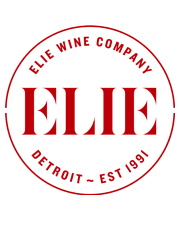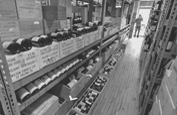Burgundy ‘Volnay’ New Guard Producer’s 2019: A Fine Balance Between Complexity and Drinkability. (4-Bottle Pack $324) + Intensity and Depth in 2012 Old Guard Volnay Gems (4-Bottle Pack $471)
No red wine appellation is more synonymous with ‘perfume’ than Volnay; the wines have historically checked all the boxes for quality, vigor and longevity but with an aromatic delicacy traditionally referred to as ‘feminine.’ The appellation has existed since 1937, and is reserved for Pinot Noir-based red wines exclusively. Although the region contains no Grand Crus, more than half of the vineyards covered by Volnay’s 526 acres are rated as Volnay Premier Crus. Just across the boundary that delimits Meursault, Volnay-Santenots is grown on terroir better suited to Pinot Noir than Meursault’s legendary Chardonnay.

The appellation stretches across a narrow band of oolitic limestone on the hill of Chaignot, with vineyards facing south-east. At the top of the slope, the soil is pink in color with pale green inclusions overlain by schist. As the ground descends, white, chalky-textured argovien limestone takes over, with a third layer of reddish Bathonien limestone finally giving way to deep gravel soils at the foot of Chaignot.
These varied soils combine to give relatively small Volnay a remarkable number of recognized lieu-dits (24) and climats classified as Premier Cru (34), each unique in expression, but yoked by an inimitable Volnay style: Spicy fragrance, elegant structure and silken mouthfeel, qualities that transcend producers, both of the traditional old guard and the innovative new.
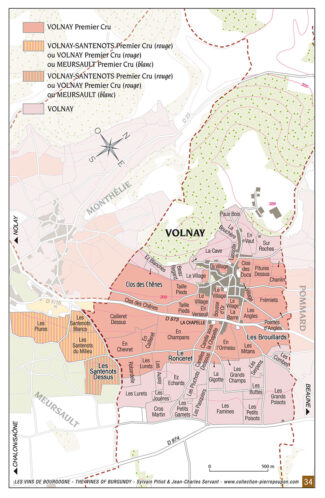
2019 Côte de Beaune Report: Perfect Conditions for a Bumper Vintage
Regarding the 2019 vintage in Côte de Beaune, Bernard Hervet (former director of Faiveley and Bouchard) states that it might rival 1865, ‘the greatest vintage of all times,’ Dimitri Bazas of Maison Champy says, “If you offer me a contract for 30 years and it promises me that every year will be like 2019, I would say, where do I sign?” The spectacular results are cellar-worthy gems of intensity, depth and precision. This is the end-product of alignment—the stars, the climate, and the experience of winemakers. The challenges of the weather were exactly what led to such phenomenal success; spring was colder than normal, with frosts in April leading to uneven flowering and by June, millerandage (a condition in which small, seedless berries appear amid healthier grapes) promised greatly reduced harvests. An extraordinarily hot summer further reduced yields, nearly cooking some grapes on the vine and making them unusable for the top maisons, but leaving the rest with an incredible depth of flavor.
Overall, the 2019 wines of Côte de Beaune possess splendid terroir expression, freshness and poise, and will improve for many years despite being highly drinkable now.
The New Guard: Domaine Georges Glantenay 2019
Brightness, vigor and delightful when youthful are among the hallmarks of Volnay’s charm, so when young siblings Guillaume and Sarah Glantenay took over Domaine Georges Glantenay from their father Pierre in the 2013 vintage, they came to symbolize the very essence of their product. Working with under twenty acres total, only half of which is in Volnay (the Glantenays have vines in Chambolle-Musigny passed down from Guillaume and Sarah’s grandmother, and also holdings in Pommard), they have embraced ‘lutte raisonnée’—a viticultural technique that translates to ‘the reasoned struggle’ and involves as little artificial intervention as possible; land is ploughed with horses and pesticides are kept to an absolute minimum. Sarah Glantenay is the brand’s ambassador, while Guillaume handles the viticulture; in the cellar, the grapes destemmed, then given a short, cool maceration, following which fermentation occurs using natural yeasts. “I look for a balance of freshness and power with a potential for aging,” Guillaume says. “2019 was a classical vintage with great density.
This special package contains one of each the following four 2019 wines for $324.
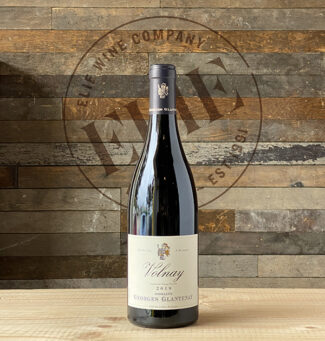 2019 Domaine Georges Glantenay, Volnay ($51):This Village-designated assembly comes from multiple plots covering the appellation from north to south and located just below the Premier Crus, including Lieux-dits ‘Les Aussy’, ‘Les Petits Gamets’, ‘La Gigotte’, ‘Les Buttes’, ‘Robardelles’, ‘Les Grands Poisots’, ‘En Echards’ and ‘Les Combes’. Ripe raspberry and candied violet on the nose; a crisp and bracing wine styled as a fully modern Volnay, from bouquet to the fresh, crunchy finish.
2019 Domaine Georges Glantenay, Volnay ($51):This Village-designated assembly comes from multiple plots covering the appellation from north to south and located just below the Premier Crus, including Lieux-dits ‘Les Aussy’, ‘Les Petits Gamets’, ‘La Gigotte’, ‘Les Buttes’, ‘Robardelles’, ‘Les Grands Poisots’, ‘En Echards’ and ‘Les Combes’. Ripe raspberry and candied violet on the nose; a crisp and bracing wine styled as a fully modern Volnay, from bouquet to the fresh, crunchy finish.
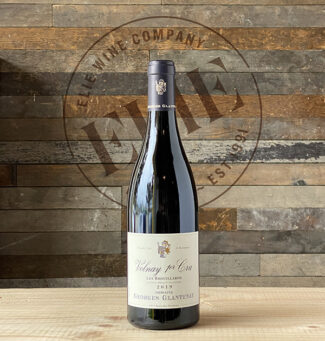 2019 Domaine Georges Glantenay, Volnay Premier Cru Les Brouillards ($94): Brouillards is the domain’s flagship wine, and their largest Premier Cru holding. It is on the Pommard side of the village, to the north of Premier Cru ‘Les Mitans’ and across the road from Premier Cru ‘Les Angles’. With about 25% whole-bunch fermentation, most of the vines date to 1950 (2 acres) and 1999 (3/4 acre). The wine is delineated and focused, and shows vibrant raspberry, black plum, sous-bois and a hint of allspice in a peppery finish.
2019 Domaine Georges Glantenay, Volnay Premier Cru Les Brouillards ($94): Brouillards is the domain’s flagship wine, and their largest Premier Cru holding. It is on the Pommard side of the village, to the north of Premier Cru ‘Les Mitans’ and across the road from Premier Cru ‘Les Angles’. With about 25% whole-bunch fermentation, most of the vines date to 1950 (2 acres) and 1999 (3/4 acre). The wine is delineated and focused, and shows vibrant raspberry, black plum, sous-bois and a hint of allspice in a peppery finish.
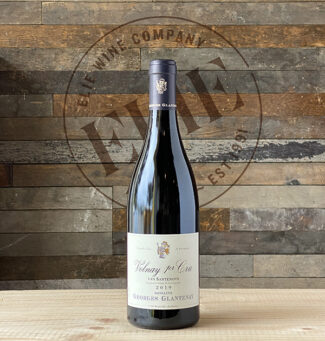 2019 Domaine Georges Glantenay, Volnay Premier Cru Les Santenots ($94):Glantenay makes two Volnay Santenots, one a white Village and this one, from 60-year-old, Guyot-trained vines in Santenots-Dessus, where soils are a mixture of clay and limestone with chalky marl subsoils. More new oak (45%) is used in this cuvée, creating a perfumed wine showing peony and rose petals and a decadent helping of cherry cobbler before an elegantly complex finish.
2019 Domaine Georges Glantenay, Volnay Premier Cru Les Santenots ($94):Glantenay makes two Volnay Santenots, one a white Village and this one, from 60-year-old, Guyot-trained vines in Santenots-Dessus, where soils are a mixture of clay and limestone with chalky marl subsoils. More new oak (45%) is used in this cuvée, creating a perfumed wine showing peony and rose petals and a decadent helping of cherry cobbler before an elegantly complex finish.
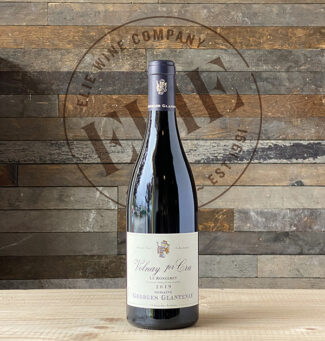 2019 Domaine Georges Glantenay, Volnay Premier Cru Le Ronceret ($85): Ronceret is located low on the Chaignot slope, just below Premier Cru ‘En Champans’. From a single acre of vines in a Premier Cru often considered the most accessible and early-drinking in Volnay, it takes its name from a term meaning ‘blackberry bush’. The fruits are redder and brighter on the nose, but darken on the palate, adding minerality and mocha to a sensuous and delightful wine.
2019 Domaine Georges Glantenay, Volnay Premier Cru Le Ronceret ($85): Ronceret is located low on the Chaignot slope, just below Premier Cru ‘En Champans’. From a single acre of vines in a Premier Cru often considered the most accessible and early-drinking in Volnay, it takes its name from a term meaning ‘blackberry bush’. The fruits are redder and brighter on the nose, but darken on the palate, adding minerality and mocha to a sensuous and delightful wine.
2012 Côte de Beaune Report: Pure and Exceptionally Concentrated
Rain and early frost delayed flowering, but that proved to be a boon since a disastrous hailstorm hit on June 6 when budding was just getting started, and so, extensive damage was avoided. More hail in the end of June along with damp weather made mildew a threat, but a heat spike in late July was welcome, at least in the best-run domains that had carefully managed canopies and avoided sunburned bunches. An outbreak of oidium (a fungal spore) followed, and when harvest began in late September, sorting was required to remove damaged or dehydrated bunches.
As a result, 2012 wound up as a spotty vintage where the best estates prevailed; it is certainly a vintage in which to trust top maisons and the best vintners.
The Old Guard: Domaine Bernard & Thierry Glantenay 2012
With roots in the 16th century, Domaine Bernard & Thierry Glantenay is an old family domain with 500 years of history in Volnay. Up until around fifteen years ago, the estate sold its grapes to négociants. That changed with Thierry taking the reins from his father, and today, the full production is sold as domain bottlings. Having trained as engineer, Thierry brings a meticulous attention to detail to his winemaking, using no more than 25% new oak for even his top wines in search of terroir expression; his goals are to showcase the purity of fruit in the delicate framing of tannin. He draws from 17 acres near the bottom of the Chaignot, where rich silt and brown clay overlay the limestone. His lieu-dit wines are considered among the best in the region, with vines between 60 and 80 years old. Thierry himself is a star in the Côte de Beaune, and as an added bonus (because he is working in the village of Volnay rather than Vosne-Romanée or Gevrey-Chambertin) his wines offer extraordinary values amid today’s stratospheric Burgundy price tags.
The additional package contains one of each the following four 2012 wines for $471
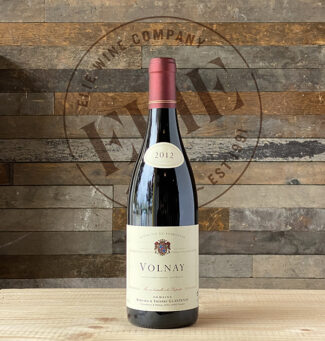 2012 Domaine Bernard & Thierry Glantenay, Volnay ($79): A Village wine assembled from several plots at the bottom of the Volnay hill, including two Premier Cru sites, Volnay Premier Cru ‘Lurets’ and Volnay Premier Cru ‘L’Ormeaux’. The other plots are from lieux-dits ‘Grands Poisets’ and ‘Buttes’. A well-crafted wine with a floral bouquet, medium-bodied with soft, supple tannins and a spicy tail.
2012 Domaine Bernard & Thierry Glantenay, Volnay ($79): A Village wine assembled from several plots at the bottom of the Volnay hill, including two Premier Cru sites, Volnay Premier Cru ‘Lurets’ and Volnay Premier Cru ‘L’Ormeaux’. The other plots are from lieux-dits ‘Grands Poisets’ and ‘Buttes’. A well-crafted wine with a floral bouquet, medium-bodied with soft, supple tannins and a spicy tail.
 2012 Domaine Bernard & Thierry Glantenay, Premier Cru Les Brouillards ($120): Around three acres in size (the domain’s largest holding), the Brouillards vineyard was planted between 1947 and 1955; the site is exceptionally well-drained and the southeast exposure ensures even ripening. It shows a generous bouquet with ripe cassis and wild strawberry scents with touches of peppermint in the background. The wine, somewhat hard on release, has mellowed and gained flesh, and provides a sensual and harmonious experience.
2012 Domaine Bernard & Thierry Glantenay, Premier Cru Les Brouillards ($120): Around three acres in size (the domain’s largest holding), the Brouillards vineyard was planted between 1947 and 1955; the site is exceptionally well-drained and the southeast exposure ensures even ripening. It shows a generous bouquet with ripe cassis and wild strawberry scents with touches of peppermint in the background. The wine, somewhat hard on release, has mellowed and gained flesh, and provides a sensual and harmonious experience.
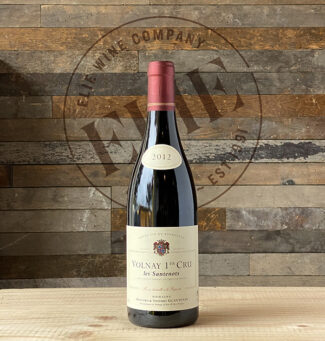 2012 Domaine Bernard & Thierry Glantenay, Premier Cru Les Santenots ($128): A little over an acre and a half in size, ‘Santenots’ is located entirely in the municipality of Meursault on red limestone soil strewn with gravel and clay on a south facing slope. With an élevage in 30% new wood lasting 15-18 months, the wine’s aromatic bouquet is marked by primary notes of Morello cherry and violet which, after several years in the bottle, has developed hints of leather, sous bois, mushrooms and spices.
2012 Domaine Bernard & Thierry Glantenay, Premier Cru Les Santenots ($128): A little over an acre and a half in size, ‘Santenots’ is located entirely in the municipality of Meursault on red limestone soil strewn with gravel and clay on a south facing slope. With an élevage in 30% new wood lasting 15-18 months, the wine’s aromatic bouquet is marked by primary notes of Morello cherry and violet which, after several years in the bottle, has developed hints of leather, sous bois, mushrooms and spices.
 2012 Domaine Bernard & Thierry Glantenay, Volnay Premier Cru Clos des Chênes ($144): The renowned ‘Clos des Chênes’ is named for the centuries-old oak trees on the outskirts of nearby Monthelie. The lot is divided into two sections, one of old vines planted in 1938 on brown, clay-rich limestone soil clay and an upper plot of younger vines planted in 2002 on white marl. Combined, the area is a bit larger than an acre. New oak is nicely integrated into red currant and citrus aromas, which lead into a clean, fresh palate with keen acidity and a structured, almost chalky texture.
2012 Domaine Bernard & Thierry Glantenay, Volnay Premier Cru Clos des Chênes ($144): The renowned ‘Clos des Chênes’ is named for the centuries-old oak trees on the outskirts of nearby Monthelie. The lot is divided into two sections, one of old vines planted in 1938 on brown, clay-rich limestone soil clay and an upper plot of younger vines planted in 2002 on white marl. Combined, the area is a bit larger than an acre. New oak is nicely integrated into red currant and citrus aromas, which lead into a clean, fresh palate with keen acidity and a structured, almost chalky texture.
- - -
Posted on 2021.11.04 in France, Burgundy | Read more...
In The Beginning Latour Created Cabernet-Merlot’s Sacred Synergy: A Bordeaux Like No Other in ‘Pauillac’ (3-Bottle Pack $375)
 The mystique of Cru Classé Bordeaux transcends that of any other man-made consumable. Reverent vignerons will insist that great wine is made in the vineyard, and yet, however vital is nature’s role—fate, circumstance and geography—no gnarled, stressed, long-suffering centenarian vine ever produced a bottle of 1961 Grand Vin de Château Latour.
The mystique of Cru Classé Bordeaux transcends that of any other man-made consumable. Reverent vignerons will insist that great wine is made in the vineyard, and yet, however vital is nature’s role—fate, circumstance and geography—no gnarled, stressed, long-suffering centenarian vine ever produced a bottle of 1961 Grand Vin de Château Latour.
Great wines, especially those that become greater as they age, are the culmination of a very human attention to mechanics and detail.
And in Bordeaux, no detail is more important than the blend—a trick the winemakers of Latour learned before Columbus got his first compass. By 1492, two thirds of the famed L’Enclos vineyard was already planted with vines, a time when most other estates often made wine merely to supplement grain crops. Latour’s terroir is not unique, but it may be considered first among equals; the 227 acres (of which 116 contain the best and oldest vines in L’Enclos) slope gently across a gravelly surface with exceptional drainage, and beneath this is a moist subsoil composed of marl, chalk and clay. This provides ample geological diversification for the blending grapes to thrive, and the estate is planted to 80% Cabernet Sauvignon, 18% Merlot, and 2% Cabernet Franc and Petit Verdot—percentages that roughly mirror the Grand Vin’s cuvée. Whereas the Grand Vin of Latour leans heavily toward Cabernet; the second wine, Les Forts de Latour, typically contains a higher percentage of Merlot and the third wine, Le Pauillac de Château Latour, even more, making them softer and more approachable in their youth.
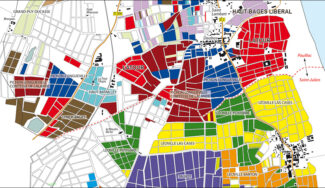
It’s the alchemy that occurs when these varieties combine that has established Bordeaux’s cache in the wine world. Blends vary from estate to estate and from vintage to vintage—flexibility is the key to success—but the two compulsory grapes are Cabernet Sauvignon and Merlot. It’s a pas de deux, a ballet in which the strengths of one shore up the strengths of the other, and any inherent weaknesses are diminished in the synergy. Cabernet (the dominant variety in the Médoc) has an inimitable savory character; peppery, dark currant fruit in the foreground with tobacco and cedar notes wrapped in brawny tannins. Merlot, in contrast, is soft stone fruit, plums especially, with silken tannins that melt into the juice. At Latour, the art of the blend is the culmination of work by more than seventy people; many had grandparents who were likewise employed at Latour. It is the meticulousness of the process, from vineyard to cellar, that requires so many hands; great wines begin in the vineyard, but they do not become great without the intervention of a conscientious human heritage.
The offered package contains three bottles of Le Pauillac de Latour for a total of $375.
Le Pauillac de Château Latour: Latour in Youth
‘Entry level’ is not a term you’d associate with a Premier Cru, but when you are as good as Latour, your third label can hold its own against many top releases. Made primarily for the restaurant industry, Le Pauillac de Château Latour is a user-friendly wine containing even more Merlot than Les Forts de Latour, making it accessible younger. This wine has been made every year since 1989, and is vinified from young vines in less prestigious sites throughout the estate using about 20% new oak barrels.
 2015 Château Latour ‘Pauillac’, Pauillac ($125): 54.2% Cabernet Sauvignon, 41.7% Merlot and 4.1% Petit Verdot. 2015 was a brilliant vintage in Pauillac; a mild winter gave way to a warm spring, ensuring bud break and flowering went off without a hitch. Fortunately, August delivered some much-needed rain, which helped correct the drought-threatened growing season. The summer was hot, but cooler nights helped retain both acidity and fresh aromatics in the grapes, and aforementioned August showers helped relieve the stress on younger vines. The ensuing harvest was easy and relaxed and the wines were, virtually across the board, collectible.
2015 Château Latour ‘Pauillac’, Pauillac ($125): 54.2% Cabernet Sauvignon, 41.7% Merlot and 4.1% Petit Verdot. 2015 was a brilliant vintage in Pauillac; a mild winter gave way to a warm spring, ensuring bud break and flowering went off without a hitch. Fortunately, August delivered some much-needed rain, which helped correct the drought-threatened growing season. The summer was hot, but cooler nights helped retain both acidity and fresh aromatics in the grapes, and aforementioned August showers helped relieve the stress on younger vines. The ensuing harvest was easy and relaxed and the wines were, virtually across the board, collectible.
Les Forts de Latour: A Pastiche of Plots
First labeled in 1966, Les Forts is Latour’s second wine, and is often made from grapes grown within the Grand Vin plot, but which did not pass the rigorous qualification process required to make it to the Grand Vin; as such, it is regarded as a Grand Cru Classé-quality wine. Largely from edge-sections of L’Enclos, but also from Cru Classé areas of Pauillac such as Piñada, Petit Batailley and St. Anne, which have belonged to the estate for more than a century, and newer vineyards in the commune of Artigues. This variety of terroirs offer Les Forts a profile that may change slightly with the vintage, but always receives the painstaking care of the Grand Vin. A notable difference is the proportion of new barrels used in the maturing stage, up to 60% for Les Forts.
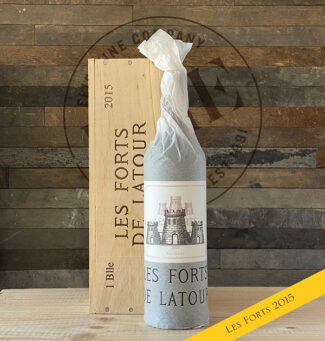 2015 Château Latour ‘Les Forts de Latour’, Pauillac ($288): A step below ‘legendary’ perhaps, 2015 was nonetheless an exceptional vintage in Pauillac, especially for long-established vineyards like Latour. An unseasonably warm spring and a heat wave in May laid the foundation for a stellar flowing, and it was followed by rain showers in June—welcome relief for the vines. July heated up and provided plenty of sunshine, although it was followed by one of the wettest Augusts in memory. These seesawing conditions affected younger vines, but those with decades of experience turned stress to advantage, providing wines that are concentrated with a wealth of fruit and firm tannins.
2015 Château Latour ‘Les Forts de Latour’, Pauillac ($288): A step below ‘legendary’ perhaps, 2015 was nonetheless an exceptional vintage in Pauillac, especially for long-established vineyards like Latour. An unseasonably warm spring and a heat wave in May laid the foundation for a stellar flowing, and it was followed by rain showers in June—welcome relief for the vines. July heated up and provided plenty of sunshine, although it was followed by one of the wettest Augusts in memory. These seesawing conditions affected younger vines, but those with decades of experience turned stress to advantage, providing wines that are concentrated with a wealth of fruit and firm tannins.
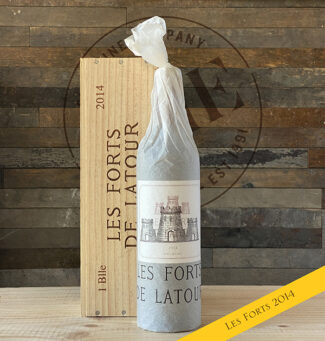 2014 Château Latour ‘Les Forts de Latour’, Pauillac ($280): 71.4% Cabernet Sauvignon and 28.6% Merlot. Pauillac was, quite arguably, the star appellation of 2014—a vintage which may be called ‘dramatic’ without overstating. For most of the season, it was shaping up to be a forgettable harvest (like 2013), but in September the weather shifted from damp to gorgeous, and a long Indian Summer that extended well into October led to a delayed harvest. One of the hallmarks of 2014 was this extended hang time, which in the finest wines manifested itself in rich, fresh fruit flavors and silky, polished tannins. As a result, the 2014 Les Forts has been called ‘Margaux-like’.
2014 Château Latour ‘Les Forts de Latour’, Pauillac ($280): 71.4% Cabernet Sauvignon and 28.6% Merlot. Pauillac was, quite arguably, the star appellation of 2014—a vintage which may be called ‘dramatic’ without overstating. For most of the season, it was shaping up to be a forgettable harvest (like 2013), but in September the weather shifted from damp to gorgeous, and a long Indian Summer that extended well into October led to a delayed harvest. One of the hallmarks of 2014 was this extended hang time, which in the finest wines manifested itself in rich, fresh fruit flavors and silky, polished tannins. As a result, the 2014 Les Forts has been called ‘Margaux-like’.
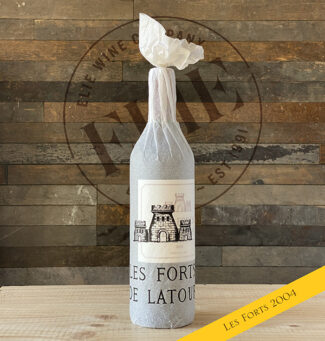 2004 Château Latour ‘Les Forts de Latour’, Pauillac ($320): 74% Cabernet Sauvignon and 26% Merlot. With an excess of vegetative growth forcing producers to be extra careful in managing foliage, and heavy August rains bloating and diluting fruit, 2004 was a spotty vintage through much of Bordeaux. But, as it is wont to do, Pauillac emerged as a top performer, buoyed along by a balmy autumn. Both the Grand Vin of Latour and Les Forts are considered classic in style; powerful, fresh and lively with concentrated fruit supported by an imposing tannic structure.
2004 Château Latour ‘Les Forts de Latour’, Pauillac ($320): 74% Cabernet Sauvignon and 26% Merlot. With an excess of vegetative growth forcing producers to be extra careful in managing foliage, and heavy August rains bloating and diluting fruit, 2004 was a spotty vintage through much of Bordeaux. But, as it is wont to do, Pauillac emerged as a top performer, buoyed along by a balmy autumn. Both the Grand Vin of Latour and Les Forts are considered classic in style; powerful, fresh and lively with concentrated fruit supported by an imposing tannic structure.
Château Latour: Le Grand Vin
First mentioned as wine producing estate in 1331, among the numerous superlatives that have attended Latour’s history, of course, none is more noteworthy than 1855’s high-water mark of accolades. That year, being named one of four Premiers Crus (First Growths) when Emperor Napoleon III requested a classification system for France’s best Bordeaux wines based on the château’s reputation and trading price, when then was directly related to quality. A fifth Premier Cru (Château Mouton Rothschild) was added in 1973, but beyond that, the list is identical to the one compiled in the mid-nineteenth century. Situated in the southeast corner of Pauillac on the border of Saint-Julien, Latour is currently owned by François Pinault as part of Groupe Artemis. Despite the high demand, relatively little is made, generally around 11,000 cases.
* The following vintages, all excellent, may appear to be somewhat random, but in fact, after 2011, Château Latour abandoned the ‘en primeur’ (future) system used in Bordeaux to sell its most recent vintages, but has chosen instead to hold back releases until after it is bottled and not until the estate feels it is ready to drink. This allows Latour to closely manage the technical and commercial life of the wine rather than relying on the Place de Bordeaux and négociants to do their marketing and sales. For consumers, this has an added benefit of allowing a greater understand of the provenance of a given Latour. According to Latour’s general director Frédéric Engerer, “We think this new commercial rhythm is in line with a growing demand from wine amateurs to be able to acquire wines that reach a ‘drinkability phase’ and that have been kept in perfect conditions in our cellars.”
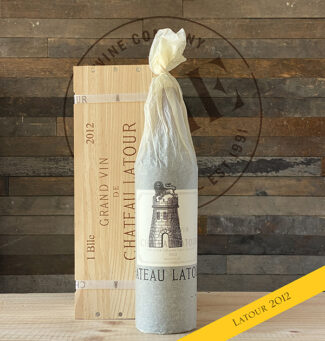 2012 Château Latour, Pauillac ($720): Latour considers 2012 a ‘late vintage’; bud break occurred on April 3 and was followed by a wet month. June was mild, but rainy, which raised the specter of mildew, but things dried up in July and by mid-August, the beginning of veraison was noted. Dry, warm weather followed, allowing a slow ripening that preserved essential acids and resulted in a fine harvest between September 24 and October 16. The wine is intense and expressive with a long finish.
2012 Château Latour, Pauillac ($720): Latour considers 2012 a ‘late vintage’; bud break occurred on April 3 and was followed by a wet month. June was mild, but rainy, which raised the specter of mildew, but things dried up in July and by mid-August, the beginning of veraison was noted. Dry, warm weather followed, allowing a slow ripening that preserved essential acids and resulted in a fine harvest between September 24 and October 16. The wine is intense and expressive with a long finish.
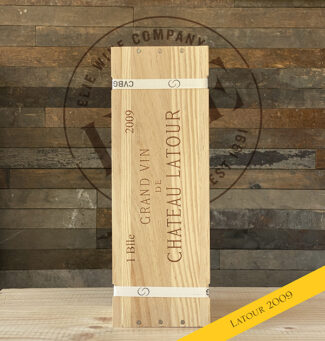 2009 Château Latour, Pauillac ($1,490): In 2009, a wet spring relinquished its hold in June, and the summer was the hottest and sunniest one since 2005. July saw a few storms, but a dry spell that lasted until veraison concentrated the juice and shrunk the berries; rain before harvest proved beneficial to refining tannins, and harvest took place from the last week of September to mid-October under splendidly sunny skies. The vintage is rated ‘exceptional’ and the wine displays extraordinary aromatic intensity and full tannins that will see improvements for many years to come.
2009 Château Latour, Pauillac ($1,490): In 2009, a wet spring relinquished its hold in June, and the summer was the hottest and sunniest one since 2005. July saw a few storms, but a dry spell that lasted until veraison concentrated the juice and shrunk the berries; rain before harvest proved beneficial to refining tannins, and harvest took place from the last week of September to mid-October under splendidly sunny skies. The vintage is rated ‘exceptional’ and the wine displays extraordinary aromatic intensity and full tannins that will see improvements for many years to come.
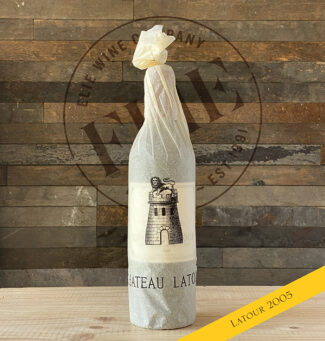 2005 Château Latour, Pauillac ($1,290): Historically, 2005 was singularly dry, a condition which generally leads to vine stress and slowed ripening. But a combination of vineyard management and the remarkable terroir within L’Enclos allowed the estate to dodge that bullet; the harvest, between September 26 and October 6, followed steady, gentle winds that concentrated the juice through evaporation, and resulted (in Pauillac specifically) in one of the most stunning vintages of the decade. The Grand Vin is exemplary, with enormously ripe fruit that should hold fast in the cellar.
2005 Château Latour, Pauillac ($1,290): Historically, 2005 was singularly dry, a condition which generally leads to vine stress and slowed ripening. But a combination of vineyard management and the remarkable terroir within L’Enclos allowed the estate to dodge that bullet; the harvest, between September 26 and October 6, followed steady, gentle winds that concentrated the juice through evaporation, and resulted (in Pauillac specifically) in one of the most stunning vintages of the decade. The Grand Vin is exemplary, with enormously ripe fruit that should hold fast in the cellar.
 2000 Château Latour, Pauillac ($1,800): In wine country, rain can be a boon or a bane, and 2000 saw both. An exceptionally wet spring resulted in difficult flowering and uneven grape sizes along with the perennial threat of mildew. But, as summers have been wont to do in Bordeaux, conditions dried out in July and August, and on September 19, an inch and a half of rain fell on L’Enclos, having the effect of ‘washing away any impurities in the grapes before harvest’, which ensued two days later and lasted until October 11. The wine is balanced and structured, and the tannins are said to rival those of 1995 and 1996, two historically phenomenal vintages.
2000 Château Latour, Pauillac ($1,800): In wine country, rain can be a boon or a bane, and 2000 saw both. An exceptionally wet spring resulted in difficult flowering and uneven grape sizes along with the perennial threat of mildew. But, as summers have been wont to do in Bordeaux, conditions dried out in July and August, and on September 19, an inch and a half of rain fell on L’Enclos, having the effect of ‘washing away any impurities in the grapes before harvest’, which ensued two days later and lasted until October 11. The wine is balanced and structured, and the tannins are said to rival those of 1995 and 1996, two historically phenomenal vintages.

Latour’s Next-door Neighbor
Château Haut-Bages Libéral 2018
An exceptional vintage in Pauillac, the 2018 Grand Vin of Cinquième Cru (Fifth Growth) Château Haut-Bages Libéral is now being compared to the legendary 2009 and 2016. In part, it goes with the territory—Haut-Bages so close to Latour that their kids probably trick-or-treat at each other’s châteaux porches—dressed, no doubt, as phylloxera lice. Incidentally, Haut-Bages refers to its position at the top of the Bages plateau between Pauillac and Saint-Julien and Libéral refers to the family who owned the estate during the 18th century. The final blend of this wine is 79% Cabernet Sauvignon and 21% Merlot. ($59)
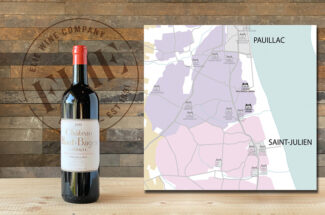
As always, we are committed to conduct the tasting in the safest way possible. We will provide glasses, but highly encourage guests to bring their own.
- - -
Posted on 2021.10.25 in Pauillac, France, Bordeaux, Saturday Sips Wines, Wine-Aid Packages | Read more...
Châteauneuf-du-Pape Dials Back to Find Its Balance and Nuance: Nine Top Producers’ 2018 Wines Show (9-Bottle Pack $499) + Pure Châteauneuf-du-Pape (4-Bottle Pack $699) + SATURDAY SIPS
Wine is evolution. The flavors behind that simple metaphor are as vast as any spectrum; it can be seen in grape vines aging gracefully, producing fruit that is increasingly concentrated and complex—it is obvious when a vigneron hones the craft of winemaking and produces better and better wines, even in challenging vintages. And of course, it is seen most profoundly inside the bottle itself, where subtle, inexorable changes occur in certain wines under controlled oxidation; bottle bouquet and polymeric pigment changes are among the most satisfying notes that mature wine offers.
But the concept of evolution may also apply to an entire appellation, and nowhere is the relatively rapid rise, fall, and rebirth of a style more evident than in Châteauneuf-du-Pape. Throughout much of its history, CdP proved a leathery foil to the potent and somewhat austere elegance of Bordeaux and the heady sensuousness of Burgundy by producing ‘southern wines’ of rustic complexity—brawny, earthy and beautiful. But as a business, wine finds itself beholden to trends, since moving product is necessary to remain afloat; during the Dark Ages (roughly 1990 through 2010—in part influenced by the preferences of powerful critic Robert Parker Jr.) much of Châteauneuf-du-Pape’s output became bandwagon wines, jammy and alcoholic, lacking structure and acids, in the process becoming more polished than rustic, more lush than nuanced. For some, this was delightful; for others, it was a betrayal of heritage and terroir.
Yet a new generation of southern Rhône winemakers (notably Jean-Paul Daumen, Thierry and Jean-Pierre Usseglio and Isabel Ferrando) seems to have identified the problem and corrected it. Recent vintages—2018 in particular—have seen the re-emergence of the classic, balanced style Châteauneuf-du-Pape, albeit at slightly higher prices. A changing climate has also altered traditional blends, so that more Mourvèdre may be found in cuvées that were once nearly all Grenache; Mourvèdre tends to have less sugar, and so produces wine less alcoholic and jammy, adding back some of the herbal qualities once so highly prized in the appellation. But a return to old school technique has also helped; many of the wines in this package were not destemmed prior to crushing and most were fermented on native yeast rather than cultured yeast.
If you survived the Fruit-Bomb era begrudgingly, you will no doubt welcome the return to the future that has begun to again take hold in Châteauneuf-du-Pape, in many ways, completing a cycle.

Châteauneuf-du-Pape 2018 Report:
A Rainy, Then Hot, Then Dry … Year Brings Richness and Balance
Châteauneuf-du-Pape is an aggressively blended cornucopia; the reality of permitting so many grape varieties in a wine that a given vintage may favor one grape at the expense of others. Most vintage reports focus on Grenache, the variety upon which CdP has (historically) staked its reputation, but the trend in local vintages has been a changing climate which more and more frequently interrupts the early-budding Grenache with frost and later, with excessive springtime rain, leading to a greater percentage of Syrah and Mourvèdre to represent the blend. Such wines tend to be lower in alcohol with a flavor profile leaning toward darker fruits and earthy minerality, so if that is the style of Châteauneuf-du-Pape you prefer, 2018 was your ideal vintage. Heavy rains in May and June caused a poor fruit set for Grenache and many growers reported a 40%-60% reduction; Syrah and Mourvèdre fared better and are pronounced in the cuvées.
This package, with nine bottles ($499), contains one bottle of each from the following CdP’s most highly regarded growers in addition to a bottle of the Saturday Sipes featured wine. A second package of four cuvées at $699 show the singular expression of Châteauneuf-du-Pape at its zenith.
Domaine de La Vieille Julienne
Jean-Paul Daumen is the 5th generation of his family to manage Vieille Julienne, and as a winemaker, he is a bit of an iconoclast. Having switched to biodynamics upon taking over the estate in 1990, he abandoned the use of all herbicides, fungicides, fertilizers and all unnatural additions including cultured yeasts. Referring to his farming method as ‘holistic’, he says, “Climatic conditions—the sun, atmospheric pressure, the effects of the moon and the planets, are some of the parameters that seem obvious to take into consideration.” He describes the terrior of Vieille Julienne as ‘soils that remain after the Rhône, which was once a torrential river that covered the entire river delta of Provence, receded.’ “There is a large amount of calcium in the earth that is sometimes overlooked when you see pictures of the alluvial quartzite galets in the vineyards.”
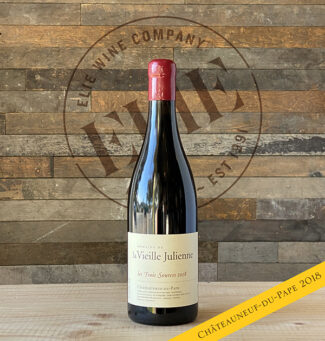 Domaine de La Vieille Julienne ‘Trois Sources’, Châteauneuf-du-Pape ($72) s from a single bloc of 21 acres in the northernmost section of Châteauneuf-du-Pape; the vineyard shares its bounty with ‘les Hauts-lieux’, although ‘Trois Sources’ is more fruit forward than the Hauts-Lieux cuvée; black currant, black licorice, violets, and some salty minerality behind pure, polished tannins.
Domaine de La Vieille Julienne ‘Trois Sources’, Châteauneuf-du-Pape ($72) s from a single bloc of 21 acres in the northernmost section of Châteauneuf-du-Pape; the vineyard shares its bounty with ‘les Hauts-lieux’, although ‘Trois Sources’ is more fruit forward than the Hauts-Lieux cuvée; black currant, black licorice, violets, and some salty minerality behind pure, polished tannins.
Domaine Charvin
Established in 1851, Domaine Charvin currently owned and operated by Laurent, the sixth-generation Charvin to run the Domaine, but he is the first to commercially market a proprietary bottling. His meticulous attention to detail sees his harvest entirely hand-picked and sorted, and bottled without filtration. Charvin produces only a single cuvée of Châteauneuf-du-Pape which is consistently rated highly; it’s drawn from a 20-acre plot composed of vines whose average age is over fifty years, mostly planted on sandy, north-facing slopes.
 Domaine Charvin, Châteauneuf-du-Pape ($61)is 85% Grenache, 5% Mourvèdre, 5% Vaccarèse, 5% Syrah; for the record, Vaccarèse is one of the rarest grapes in Châteauneuf-du-Pape, with just over 10 acres planted in total and little more grown elsewhere. It contributes notes of pine forest and minty juniper to the wine, which shows brawny boysenberry jelly concentrated by hints of allspice and bitter chocolate. 2500 cases produced.
Domaine Charvin, Châteauneuf-du-Pape ($61)is 85% Grenache, 5% Mourvèdre, 5% Vaccarèse, 5% Syrah; for the record, Vaccarèse is one of the rarest grapes in Châteauneuf-du-Pape, with just over 10 acres planted in total and little more grown elsewhere. It contributes notes of pine forest and minty juniper to the wine, which shows brawny boysenberry jelly concentrated by hints of allspice and bitter chocolate. 2500 cases produced.
Domaine Santa Duc
At the foot of the Dentelles de Montmirail, six generations of the family Gras have succeeded each other at the helm of Santa Duc; since the 2017 vintage, Benjamin Gras claims the honor, and with it, inherits a tradition of massal selections, biodynamics, whole cluster vinification, fermentation with wild yeasts, minimum intervention and non-filtered wines. “We produce terroir wines,” he explains, “and biodynamics is the best tool—it allows you to bring microorganisms directly into the soil.” Mirroring the re-emergence of the more nuanced style of Châteauneuf-du-Pape, he calls winemaking ‘an evolution’. “Each year I have to ask myself questions in how to produce better wine. We shortened the maceration so there is less extraction in the cellar—I try to do nothing to degrade the quality of the grape itself.”
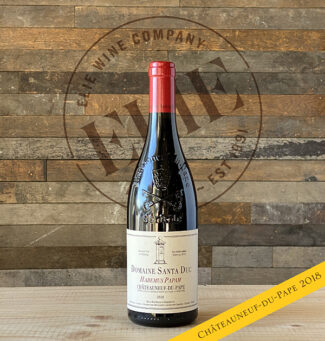 Domaine Santa Duc ‘Habemus Papam’, Châteauneuf-du-Pape ($54)comes from small plots (less than five acres total) found at Le Pradel and La Font du Pape, to the east and center of Châteauneuf-du-Pape, where the soils are rich in sandy clay on the surface with calcareous subsoils beneath. 70% Grenache, it is 30% Syrah—La Font du Pape translates to ‘a place where water is to be found’, ideal for Syrah to express fresh crispness and shows plum compote, the signature garrigue aromatics of Southern Rhône, toasted spices and a marvelous balance of floral delicacy and taut CdP strength.
Domaine Santa Duc ‘Habemus Papam’, Châteauneuf-du-Pape ($54)comes from small plots (less than five acres total) found at Le Pradel and La Font du Pape, to the east and center of Châteauneuf-du-Pape, where the soils are rich in sandy clay on the surface with calcareous subsoils beneath. 70% Grenache, it is 30% Syrah—La Font du Pape translates to ‘a place where water is to be found’, ideal for Syrah to express fresh crispness and shows plum compote, the signature garrigue aromatics of Southern Rhône, toasted spices and a marvelous balance of floral delicacy and taut CdP strength.
Domaine de Beaurenard
A family-run estate for eight generations, brothers Daniel & Frédéric Coulon and Daniel’s sons Victor and Antonin carry forward the torch amid a mosaic of limestone, round pebbles on a clay substrate with varying amounts of iron and fine sedimentary sand. There are 13 legally permitted varieties in Châteauneuf-du-Pape, and Beaurenard grows them all. After allowing a specific plot to remain fallow for twelve years, the Coulons splice-grafted each allowable grape variety chosen from the estate’s oldest vines and created a Conservatory: “Our primary goal was to safeguard the natural genetic heritage that is particularly well adapted to the terroir. But we were also mindful of future generations, and if global warning continues, to increase the proportion of varieties that contain less sugar and contribute aromatic complexity.”
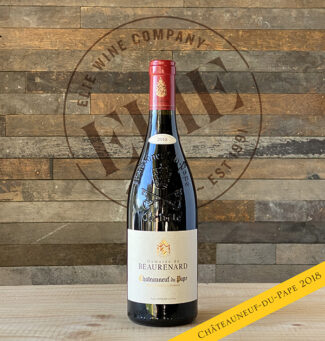 Domaine de Beaurenard, Châteauneuf-du-Pape ($62) , although primarily Grenache, does indeed contain all thirteen allowable grape varieties. Hand-picked and sorted in the vineyard, co-fermented and vatted for an extended period for soft extraction. The estate’s flagship wine is expressive and bold, displaying bright cherry cola and raspberry jam flavors with smoke, earth, espresso, wild mushroom and an elegant and lively finish laced with ripe tannins.
Domaine de Beaurenard, Châteauneuf-du-Pape ($62) , although primarily Grenache, does indeed contain all thirteen allowable grape varieties. Hand-picked and sorted in the vineyard, co-fermented and vatted for an extended period for soft extraction. The estate’s flagship wine is expressive and bold, displaying bright cherry cola and raspberry jam flavors with smoke, earth, espresso, wild mushroom and an elegant and lively finish laced with ripe tannins.
Domaine Pierre Usseglio
New by Châteauneuf standards, Pierre Usseglio was founded in 1948 by Italian émigré Pierre Usseglio. In 1998, he turned over the operations to his sons Thierry and Jean-Pierre Usseglio, who now balance their time between the cellar and the vineyard. Of the estate’s hundred acres, about sixty are planted to Châteauneuf-du-Pape red varieties, the rest to Châteauneuf-du-Pape white, Lirac red, Côtes-du-Rhône and Vin de France.
 Domaine Pierre Usseglio, Châteauneuf-du-Pape ($49) is 55% Grenache, 25% Syrah, 15% Mourvèdre and 5% Cinsault displays the purity of the domain’s terroir with classic scents of sun-warmed stones, black cherries, graphite and anise accented wood spice; a solid tannic grip and energy for cellaring.
Domaine Pierre Usseglio, Châteauneuf-du-Pape ($49) is 55% Grenache, 25% Syrah, 15% Mourvèdre and 5% Cinsault displays the purity of the domain’s terroir with classic scents of sun-warmed stones, black cherries, graphite and anise accented wood spice; a solid tannic grip and energy for cellaring.
Domaine La Barroche
In the Châteauneuf-du-Pape, there is old, there is very old, and there is Domaine La Barroche, which has been in the same family since the 14th century—it is currently managed by the sister and brother team of Laetitia and Julien Barrot. The vines themselves lay a similar claim to gravitas; at over 100 years of age, the estate’s Grenache plantings are among the oldest in the appellation. At around 30 acres, La Barroche is a comfortably small parcel that ensures rigorous bud pruning, green harvesting, and leaf thinning; up until 2002, when the siblings took over, all the grapes were sold to négociants. And so, in an ancient holding, Julien and Laetitia have taken their father’s work to the next level, moving to estate bottlings of organic agriculture, vinifying each grape variety (and some parcels) separately, studying and learning as they go.
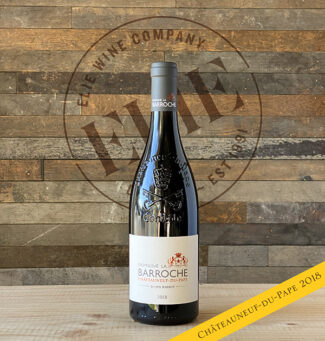 Domaine La Barroche ‘Signature’, Châteauneuf-du-Pape ($45) The blend is 60% Grenache, 19% Mourvèdre and a balanced mix of other permitted varieties, all grown in the red clay and yellow sands typical of the region; the wine is full-bodied and generously sumptuous, with sweet black raspberry notes above seascape herbs (tarragon and thyme) and velvety mocha at the finish.
Domaine La Barroche ‘Signature’, Châteauneuf-du-Pape ($45) The blend is 60% Grenache, 19% Mourvèdre and a balanced mix of other permitted varieties, all grown in the red clay and yellow sands typical of the region; the wine is full-bodied and generously sumptuous, with sweet black raspberry notes above seascape herbs (tarragon and thyme) and velvety mocha at the finish.
Domaine Saint Préfert
Isabel Ferrando is the force behind Saint Préfert, and one of the most respected winemakers in France; her reputation has grown every vintage since her first release in 2003. From the 55-acre estate in the south of CdP, she produces five cuvées, two whites and three reds. The vines are old, but her team is young and she is always open to new ideas; she relies on tradition without being trapped by it. For example, she has taken to Stockinger as a supplier of oak for maturation, claiming that the Austrian cooperage results in more tension in the wines. In the 2009 vintage, Ferrando started working with whole-cluster fermentation without added yeasts, and discovered that this magnified freshness in the wines. “In ten years,” she maintains, “I’ve progressed. My sensitivity to the terroir is much more pronounced.”
 Domaine Saint Préfert ‘Classique’, Châteauneuf-du-Pape ($52) is 85% Grenache and 5% each of Syrah, Mourvèdre, and Cinsault; a beautifully perfumed and nuanced wine with classic notes of strawberries, cherries, loam, earth and dried flowers, polished, elegant and silky on the palate.
Domaine Saint Préfert ‘Classique’, Châteauneuf-du-Pape ($52) is 85% Grenache and 5% each of Syrah, Mourvèdre, and Cinsault; a beautifully perfumed and nuanced wine with classic notes of strawberries, cherries, loam, earth and dried flowers, polished, elegant and silky on the palate.
Domaine du Vieux Télégraphe
Châteauneuf-du-Pape is perhaps the most celebrated AOP in southern Rhône, and La Crau is arguably Châteauneuf-du-Pape’s grandest cru. The Brunier family has been a fixture on the plateau of La Crau since the late nineteenth century, when Hippolyte Brunier made wine from a couple acres of land. His vineyard was not only small, but it was on one the highest, most inhospitable terrains between Châteauneuf-du-Pape and Bédarrides—the elevation had prompted the construction of a communication tower century ago to transmit between Marseille and Paris, and hence, the winery’s name. But lousy ground often creates superb wine, and it so happened that the reputation of his tiny, barren parcel of galets roulés—rounded stones—traveled faster than a telegraph message, and Brunier gradually expanded his holdings. Today, the assemblage that bears the name of the flagship wine is made exclusively from the estate’s older vines; fruit produced by younger vines end up in Vieux Télégraphe’s second label, ‘Télégramme’.
 Domaine du Vieux Télégraphe ‘Télégramme’, Châteauneuf-du-Pape ($49)80% Grenache, 10% Syrah, 6% Mourvèdre, 4% Cinsault. Juicy and robust, the fruit profile is generous with layers of blueberry, ripe cherry compote and cassis tinged with smoke and finishing with supple, structured tannins.
Domaine du Vieux Télégraphe ‘Télégramme’, Châteauneuf-du-Pape ($49)80% Grenache, 10% Syrah, 6% Mourvèdre, 4% Cinsault. Juicy and robust, the fruit profile is generous with layers of blueberry, ripe cherry compote and cassis tinged with smoke and finishing with supple, structured tannins.
Very Old Vines, Low Yields, Natural Approach:
Pure Châteauneuf-du-Pape (4-Bottle Pack $699)
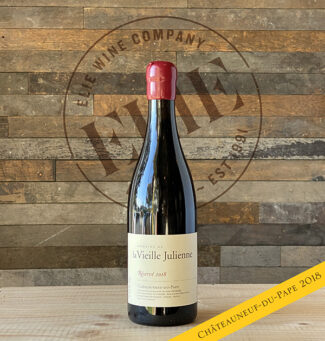 Domaine de La Vieille Julienne ‘Réservé’ ($312)Exclusively from more than a hundred-year old vines of Grenache (90%), Syrah, Cinsault and Counoise, and vinified separately. A wine with extraordinary concentration and sublime freshness; rich and sappy with sweet red berry preserve and candied lavender notes shored by black licorice, smoky earth, with sheets of glossy, ripe and perfectly integrated tannins behind seamless acidity.
Domaine de La Vieille Julienne ‘Réservé’ ($312)Exclusively from more than a hundred-year old vines of Grenache (90%), Syrah, Cinsault and Counoise, and vinified separately. A wine with extraordinary concentration and sublime freshness; rich and sappy with sweet red berry preserve and candied lavender notes shored by black licorice, smoky earth, with sheets of glossy, ripe and perfectly integrated tannins behind seamless acidity.
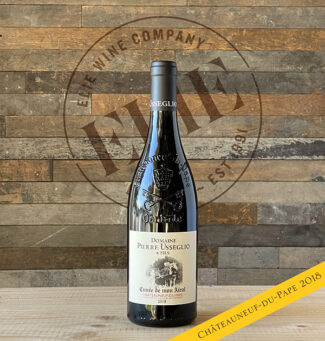 Domaine Pierre Usseglio ‘Cuvée de Mon Aïeul’ ($112)Pure Grenache from 75 to 90-year-old vines in select parcels in Lieux-dits La Crau, Les Bédines and Les Serres. An expansive, complex bouquet with layers of cherry liqueur, exotic incense and dried spices; the warm fruit resolves into cooling graphite and an opulent finish without hard edges. 100% Grenache.
Domaine Pierre Usseglio ‘Cuvée de Mon Aïeul’ ($112)Pure Grenache from 75 to 90-year-old vines in select parcels in Lieux-dits La Crau, Les Bédines and Les Serres. An expansive, complex bouquet with layers of cherry liqueur, exotic incense and dried spices; the warm fruit resolves into cooling graphite and an opulent finish without hard edges. 100% Grenache.
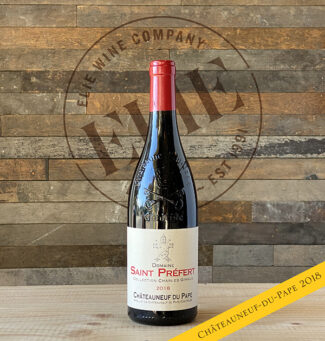 Domaine Saint Préfert ‘Collection Charles Giraud’ ($160) 60% Grenache and 40% Mourvèdre from 80-year-old vines, the wine is voluptuous and penetrating with aromas of peppery garrigue, smoked meats, blackcurrants, opulent, piercing and honed with feathery tannins and an undertow of fresh acidity. 100% Grenache.
Domaine Saint Préfert ‘Collection Charles Giraud’ ($160) 60% Grenache and 40% Mourvèdre from 80-year-old vines, the wine is voluptuous and penetrating with aromas of peppery garrigue, smoked meats, blackcurrants, opulent, piercing and honed with feathery tannins and an undertow of fresh acidity. 100% Grenache.
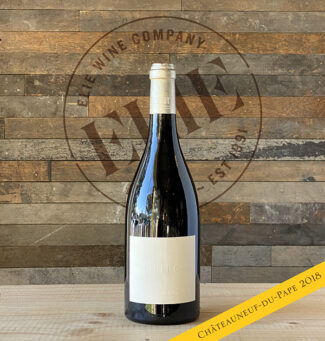 Domaine La Barroche ‘Pure’, Châteauneuf-du-Pape ($128) From century-old Grenache vines deeply rooted in a single parcel with sandy and red Comtat sandstone soil the 2018 cuvée ‘Pure’ is a full-bodied beauty. Fully ripe, boasting notes of black cherries, wild herbs and hints of dark chocolate, it nevertheless comes across as silky and almost airy on the palate, while showing real intensity and length on the licorice-tinged finish.
Domaine La Barroche ‘Pure’, Châteauneuf-du-Pape ($128) From century-old Grenache vines deeply rooted in a single parcel with sandy and red Comtat sandstone soil the 2018 cuvée ‘Pure’ is a full-bodied beauty. Fully ripe, boasting notes of black cherries, wild herbs and hints of dark chocolate, it nevertheless comes across as silky and almost airy on the palate, while showing real intensity and length on the licorice-tinged finish.

Château de la Font du Loup ‘Le Puy Rolland – Vieilles Vignes’, Châteauneuf-du-Pape 2018
Long name, old vines: Anne-Charlotte Mélia-Bachas crafts her CdP at La Font du Loup from centenarian-plus vines planted in cool, high-elevation sandy soils on a north-facing plot directly behind La Crau; the result is a wine that is as elegant and pure as it is complex. Made of 100% Grenache, it showcases the variety’s characteristic spicy fruit. Only 500 cases were made of this vintage. ($55)

As always, we are committed to conduct the tasting in the safest way possible. We will provide glasses, but highly encourage guests to bring their own.
- - -
Posted on 2021.10.16 in Châteauneuf-du-Pape, France, Wine-Aid Packages, Southern Rhone | Read more...
‘Mercurey’ Rising: Four Standout Producers Soar in Burgundy’s Hidden Jewel with Red & White – (7-Bottle Pack $310, Tax Included) + SATURDAY SIPS Returns
Like the Roman god from which this appellation takes its name, Mercurey is often associated with the color red—and that’s because 90% of Mercurey’s vinous output is Pinot Noir. Situated in the heart of the Chalonnaise, Mercurey claims about 1600 acres of land under vine; 1300 are Pinot Noir with the remainder divided between Chardonnay, Pinot Blanc, Pinot Gris and Aligoté.
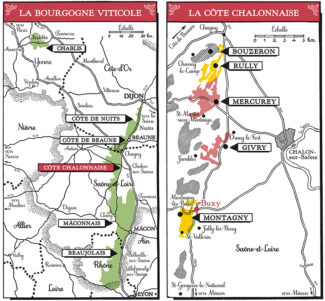
Jean-Pierre Renard, who teaches wine appreciation and tasting at the École des Vins de Bourgogne, describes Mercurey’s orientation as identical to that of the Côte Chalonnaise—north to northeast and south to southwest, with the Golden Valley running down the middle. On the eastern side, vines are planted in calcic soils of Oxfordian limestone, while in the west, crystalline Jurassic rocks are overlain by gravel. Protected from moisture-bearing winds by the hillsides, the vineyards stretch as far as the neighboring village of Saint-Martin-sous-Montaigu. According to local grower Amaury Devillard, Mercurey is a hidden jewel among Bourgogne wines and remains one of the best price/quality wines available: “It was once known as a rustic wine, but the Mercurey of today is completely different. Our wines express fruitiness, cherries especially, with a nice spiciness in the finish.”
 This improvement in quality is in part because many Mercurey winemakers are better than the AOP might suggest. Although up to 15% of Chardonnay, Pinot Blanc and Pinot Gris are permitted as accessory grapes in the red wines, this is rarely practiced, and certainly never in the Premier Cru wines, which make up a quarter of all vineyards and account for 31 officially recognized and delimited climats.
This improvement in quality is in part because many Mercurey winemakers are better than the AOP might suggest. Although up to 15% of Chardonnay, Pinot Blanc and Pinot Gris are permitted as accessory grapes in the red wines, this is rarely practiced, and certainly never in the Premier Cru wines, which make up a quarter of all vineyards and account for 31 officially recognized and delimited climats.
Magical (2019) Vintage: Fresh with an Indulgent Side
Could 2019 rival 1865, arguably the greatest Burgundian vintage of all times? According to Bernard Hervet, former director of Faiveley and Bouchard, it could. The winter was mild but spring was chilly; to some extent, crop yields were limited by frost during bud break and further by a hailstorm on July 7, but the berries that survived were richly concentrated. Late summer heat threatened to produce jammy wines (the antithesis of the Burgundian paradigm, which calls for freshness and tension), but those picked early enough are very well-balanced. In general, the wines display precise fruit with elegant tannins and lively acidity; wines from top estates have excellent aging potential, but nearly all of them are already open and enjoyable.
Ideal (2018) Vintage: Richness, Complexity and Elegance
The upside of a very dry growing season like 2018 is that mildew is minimized along with most of the other diseases that thrive in damp summers. Drought stress played a factor in yield reduction, and growers were forced to call on all their skills to preserve freshness, since the already-concentrated fruit ripened quickly and became more concentrated in the heat. Top houses know that perfect skin ripeness is key to producing superlative Burgundy, and the balance between phenolic ripeness and acid preservation is what sets them apart. Wines from the Chalonnaise turned out particularly well in 2018; many growers produced soaring red wines with textbook balance.
Domaine du Cellier aux Moines
The domain has a history as long and fascinating as any in Burgundy. In 1113 twelve monks left the Abbey of Citeaux and headed south to the Chalonnaise, where Foulques de Reon (the Count of Chalon) gifted them a parcel of cleared land in order to establish a new Abbey. Naturally, being Burgundian monks, they started producing wine, and thus was born the Domaine du Cellier Aux Moines, which is still producing superlative Premier Cru wines to this day.
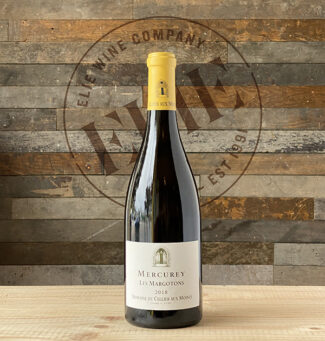
2018 Domaine du Cellier aux Moines ‘Les Margotons’ Mercurey White ($31) is a relative rare beast in Mercurey, 100% Chardonnay. Les Margotons is a single northeast-facing vineyard planted in 1987, about an acre and a half in size, whose white marl soil base and cool, hillside exposures produces distinctly tropical flavors in the wine; crushed pineapple and bright white floral notes are enhanced by toasted hazelnut and vanilla and finishing with peach and crisp minerality.
Domaine Faiveley
Synonymous with fine Burgundy, Domaine Faiveley has been a fixture in Nuits-Saint-Georges since 1825 when négociant Joseph Faiveley began traveling through Europe trading wine for textiles. Today, it is still run by his family; Eve and Erwan Faiveley, and the original estate has extended throughout the Côte de Nuits and into the Côte Chalonnaise and Chablis.
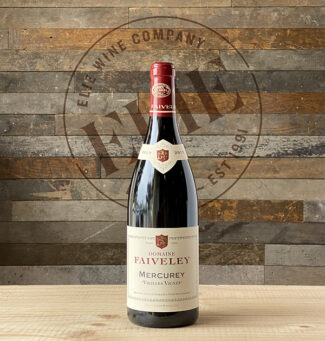 2019 Domaine Faiveley ‘Vieilles Vignes’ Mercurey Red ($43): ‘Vieilles Vignes’ means ‘old vines’ of course, and at thirty-years plus (planted in 1962, 1978 and 1981), these may not be the oldest vines in Mercurey, but they are producing splendidly. After fermentation, the wine is aged for 12 months in French oak barrels (10% of which are new) and show a wine that is round and ripe with vivid cherry notes embedded in a velvety body which remains firm and muscular, yet aligned with poise.
2019 Domaine Faiveley ‘Vieilles Vignes’ Mercurey Red ($43): ‘Vieilles Vignes’ means ‘old vines’ of course, and at thirty-years plus (planted in 1962, 1978 and 1981), these may not be the oldest vines in Mercurey, but they are producing splendidly. After fermentation, the wine is aged for 12 months in French oak barrels (10% of which are new) and show a wine that is round and ripe with vivid cherry notes embedded in a velvety body which remains firm and muscular, yet aligned with poise.
Domaine Adélie
Encompassing 19 southwest-facing acres in the heart of the Chalonnaise, Domaine Adélierepresents the final acquisition of Maison Albert Bichot, and produces both Village and Premier Cru wines. The estate was named for Bichot’s daughter, and the daughter was in turn named for Adélie Land in Antarctica, which the adventure-loving Bichot once visited. Despite his travels, Bichot states without reserve: “I will always feel like a Burgundian. These are my roots.”
 2019 Domaine Adélie, Mercurey Lieu-dit ‘En Pierre Milley’ Red ($50), from 4.9-acre vineyard with 35-year old vines, is a plot-specific wine that displays Mercurey’s sumptuous candy-red, spiced-cherry profile shored up by silky tannins and a long, harmonious finish.
2019 Domaine Adélie, Mercurey Lieu-dit ‘En Pierre Milley’ Red ($50), from 4.9-acre vineyard with 35-year old vines, is a plot-specific wine that displays Mercurey’s sumptuous candy-red, spiced-cherry profile shored up by silky tannins and a long, harmonious finish.

Château de Chamirey
In 1934, the Marquis de Jouennes began to bottle the wines of Château de Chamirey at the domaine; his son-in-law, Bertrand Devillard took over, and expanded the holdings to the present size. Today, Amaury and Aurore Devillard stand proud as the 5th generation of the family to manage the estate. Of the 95 acres that encompass de Chamirey’s vineyards, about 70 are dedicated to Pinot Noir and the rest to Chardonnay; of the total, 21 acres are Premier Cru and about eight represent the acres for which de Chamirey is best known, Monopole wines, including those of La Mission and Clos du Roi. The peculiarly Burgundian term ‘Monopole’ dates back to Napoleonic inheritance laws that saw properties so subdivided (even down to individual rows of vines) that a lone grower was often not able to provide commercial grape quantities to négociants. A ‘Monopole’ wine represents a single area, often a lieu-dit vineyard, controlled by a single winery.
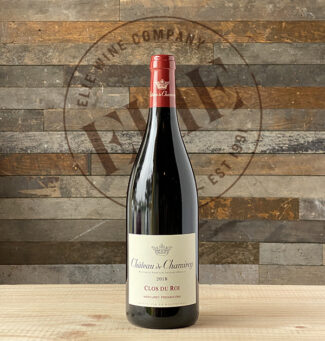 2018 Château de Chamirey Mercurey Premier Cru Clos du Roi Red ($52): To elicit the maximum extraction of color and phenolic compounds, the Pinot Noir is held pre-fermentation between 4 and 6 days, following which a full two-week maceration concentrates tannins and aromatics. Clos du Roi is a southwest-facing, concave slope divided into 4 adjacent plots for a total of 7.6 acres planted between 1970 and 2002. The nose shows expressive strawberry and raspberry notes behind pie spices (cinnamon and nutmeg); the palate is cherries, plums, cassis, licorice and candied citrus peel.
2018 Château de Chamirey Mercurey Premier Cru Clos du Roi Red ($52): To elicit the maximum extraction of color and phenolic compounds, the Pinot Noir is held pre-fermentation between 4 and 6 days, following which a full two-week maceration concentrates tannins and aromatics. Clos du Roi is a southwest-facing, concave slope divided into 4 adjacent plots for a total of 7.6 acres planted between 1970 and 2002. The nose shows expressive strawberry and raspberry notes behind pie spices (cinnamon and nutmeg); the palate is cherries, plums, cassis, licorice and candied citrus peel.
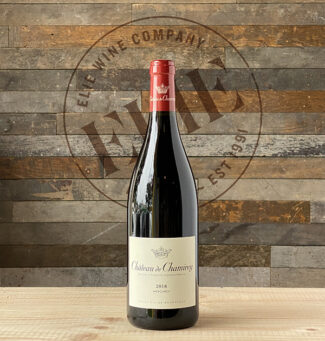 2018 Château de Chamirey Mercurey Red ($31) A composite of 10 small plots in addition to 3 plots of Premier Cru (En Sazenay, Champs-Martin and Clos L’Évêque), the wine exhibits anise, black current and toasty smoke notes compliments a core of candied cherry.
2018 Château de Chamirey Mercurey Red ($31) A composite of 10 small plots in addition to 3 plots of Premier Cru (En Sazenay, Champs-Martin and Clos L’Évêque), the wine exhibits anise, black current and toasty smoke notes compliments a core of candied cherry.
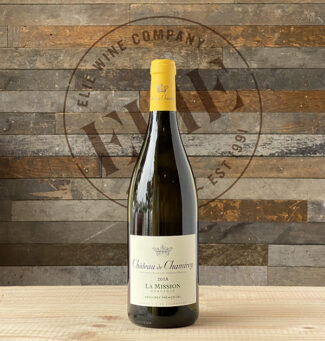 2018 Château de Chamirey Mercurey Premier Cru La Mission (Monopole) White ($54): With vines planted between 1961 and 1997, this five-acre Monopole grows in a mix of sand and clay on a hilltop overlooking Clos du Roi. Grapes are harvested and sorted by hand and fermented in lightly toasted Allier and Voges oak, then aged in 228-liter barrels of the same cooperage. Balanced and nicely dense, the wine shows creamy lime and vanilla notes behind buttered brioche with a long, caramelized finish.
2018 Château de Chamirey Mercurey Premier Cru La Mission (Monopole) White ($54): With vines planted between 1961 and 1997, this five-acre Monopole grows in a mix of sand and clay on a hilltop overlooking Clos du Roi. Grapes are harvested and sorted by hand and fermented in lightly toasted Allier and Voges oak, then aged in 228-liter barrels of the same cooperage. Balanced and nicely dense, the wine shows creamy lime and vanilla notes behind buttered brioche with a long, caramelized finish.
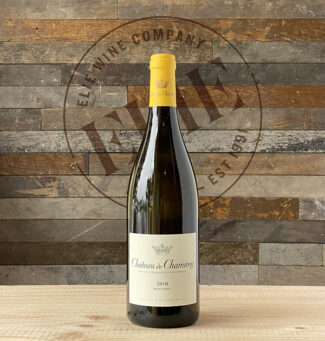 2018 Château de Chamirey Mercurey White ($31):Raised from 6 different plots across the village, the diversity and typicity of each plot reflect their richness in the wine. A floral nose redolent of white springtime blossoms; fresh, vibrant, and crisp with discreet flavors of ripe peaches, light spice and a nice backbone of acidity.
2018 Château de Chamirey Mercurey White ($31):Raised from 6 different plots across the village, the diversity and typicity of each plot reflect their richness in the wine. A floral nose redolent of white springtime blossoms; fresh, vibrant, and crisp with discreet flavors of ripe peaches, light spice and a nice backbone of acidity.

At long last, we announce the return of Saturday Sips with a tasting of Domaine de la Ferté (Givry 2019).
Formerly the epicenter of wine production in the Côte Chalonnaise, Givry was the preferred source for King Henri IV’s wines in the 16th Century, and still represents some of best values in the Côte. Domaine de la Ferté is one of five estates owned by the Devillard family (which also includes Château de Chamirey, above); Ferté covers a relatively small area of six acres spread over three plots, two in the village appellation of Clos Mortière and one in Servoisine Premier Cru. It thrives under the direction of enologist and ‘chef de culture’ Enrico Peyron.
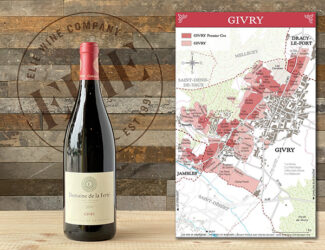
As always, we are committed to conduct the tasting in the safest way possible. We will provide glasses, but highly encourage guests to bring their own.
- - -
Posted on 2021.10.07 in Côte Chalonnaise, Mercurey, France, Saturday Sips Wines, Burgundy, Wine-Aid Packages | Read more...
The Art of The Blend – Haut-Médoc Winemakers are the Real Face of Bordeaux: Six Producers Shine in 2018. (12-Bottle Pack $297, Tax Included)
‘Bordeaux blend’ (which, ironically, never appears on a Bordeaux label) is a loaded term, meant to elicit emotion and stir memories. That’s not a bad thing: In fact, it’s a paean to the world’s most synergistic appellation, where the art of the blend is the soul of the substance.
In France, wine discussions generally center on terroir—a sense of place—and the winemaker—the alchemy that someone discovers within their terroir. Grape varieties rarely enter the conversation except academically, because they are either a given, like in Burgundy, which circles single variety reds (Pinot Noir) and whites (Chardonnay), or else the art of the blend creates a wine that end up being greater than the sum of its parts.
Bordeaux is a complicated beast, bestowed with geography and climate that lends itself to the nurturing of multiple grape varieties. The wisdom of experience has honed the list of legally allowable grapes to six for red wine (Cabernet Sauvignon, Cabernet Franc, Merlot, Malbec, Carménère, and Petit Verdot), although climate change has become such a fact of life in Bordeaux that last year, in an effort to address global warming, France’s Institut National de l’Origine et de la Qualité INAO officially upended tradition and approved four new red wine grapes for Bordeaux, Arinarnoa, Castets, Marselan, and Touriga Nacional. The future will dictate how they perform in blends.
The Art of The Blend
The art of the blend begins before the first vine is planted; Bordeaux is a vast quilt of soil types that make some plots better suited for Merlot, others for Cabernet Franc, and so on. Each grape has a laundry list of physiological requirements, and the wise grower is in tune with them all. Thus, the graveled, quick-draining acres of Bordeaux’s Left Bank tend to be planted to Cabernet Sauvignon—a grape which thrives best with dry feet and delves deeply into the ground to produce juice bright with acidity, while the clay-heavy, moisture-retaining soil of the Right Bank is the environment preferred by Merlot, where the results are muscular and fleshy. Yet individual estates rarely possess monolithic geologies, and changing elevations offer certain vineyard sites better sun and wind exposures; as a result, most châteaux plant at least a couple types of grapes. And in the Haut-Médoc, home to some of Bordeaux’s most revered estates, the 10,000 acres of vineland is about half Cabernet Sauvignon with the rest divvied up between Merlot and Petit Verdot along with a negligible quantities of Malbec.
In any winery, once the grapes are harvested, the cellar work begins, and this is when the artisan winemaker truly plies his/her craft; the art of the blend. You cannot change vine placement or cultivars without extensive work, but a vigneron can (and must) evaluate how each variety does over the course of a growing season. That determines next steps, including varietal percentages for the final cuvée, extraction levels, élevage times (in oak, concrete or steel), whether malolactic fermentation is necessary to tame acids, and, of utmost importance, whether the wine will be aged as separate components or as a married blend. Rarely is there anything random about such decision-making; it is the culmination of experience and finely-honed palates. A winemaker must understand intrinsically not only how the wine will perform in the barrel, but how it will change inside the bottle over many years.
 Haut-Médoc is a sub-appellation of the Médoc AOP, and represents only a small fraction of Médoc wines. Of the fifteen wine-producing communes of the Haut-Médoc, eight are located along the waterfront of Garonne and Gironde while seven lie inland. Originally an area of salt marsh, most of Haut-Médoc’s early agricultural history involved animal grazing rather than viticulture, so credit is due to 17th century Dutch merchants for engineering a drainage project to convert sufficient marshland into vineyards in order to provide the burgeoning British wine market with an alternative to the Portuguese wines then in vogue. It is fair to say that their mission was accomplished. Still, the climate of Bordeaux is subject to more fluctuation than, say, Oporto, and growers remain beholden to nature.
Haut-Médoc is a sub-appellation of the Médoc AOP, and represents only a small fraction of Médoc wines. Of the fifteen wine-producing communes of the Haut-Médoc, eight are located along the waterfront of Garonne and Gironde while seven lie inland. Originally an area of salt marsh, most of Haut-Médoc’s early agricultural history involved animal grazing rather than viticulture, so credit is due to 17th century Dutch merchants for engineering a drainage project to convert sufficient marshland into vineyards in order to provide the burgeoning British wine market with an alternative to the Portuguese wines then in vogue. It is fair to say that their mission was accomplished. Still, the climate of Bordeaux is subject to more fluctuation than, say, Oporto, and growers remain beholden to nature.
Haut-Médoc Has Delivered a Top Vintage in 2018
2018 was the sort of schizophrenic, binary season that has become more common in recent years, no doubt the result of global warming. Hard and steady rains in the first half of 2018 were followed by prolonged periods of heat and drought. With water tables raised sufficiently high, the vines did not suffer tremendously, but like all living things, extremes are not optimal—it’s like guzzling water on Monday, without access to water for rest of the week. Still, other than a hailstorm that decimated at least one estate, Haut-Médoc did well in 2018; the broad Gironde helps moderate summer temperatures and the skill and experience of the winemaker came into play; the art of the blend enabled some of the region’s lesser-known châteaux to conjure up marvelous wines that represent outstanding values.
This package, with dozen bottles ($297, all inclusive), contains selections from six of Haut-Médoc’s most highly regarded growers. The diversity of the wines in this package explains the variety of different terroirs over this area, a rarity within one and the same appellation. Despite these differences due to this mosaic of climatic and geological influence, the wines share the same family traits.
Château Larrivaux
‘The Patriarchy’ may have gotten bad press over the past few years, but that has never been a concern at Larrivaux, which has been handed down through a line of women since 1580. These days, the triumvirate of Armelle Carlsberg, Sabine Carlsberg and her daughter Bérangère Tesseron run the estate—the latter is the wife of Basile Tesseron of 4th Growth Château Lafon-Rochet in nearby Saint-Estèphe, who in turn is the the nephew of Pauillac luminary Alfred Tesseron of Château Pontet-Canet. Larrivaux is in the north of Haut-Médoc, where the soils contain a greater percentage of limestone. As such, the fifty acres of vine are planted to a greater proportion of Merlot than much of the appellation, and as a result, the wines display a rich, plum/cassis profile.

Château Larrivaux Haut-Médoc ($27)
It is composed of 64% Merlot, 26% Cabernet Sauvignon and Cabernet Franc with Petit Verdot in the balance. Bold and saturated, the wine retains a plushness that glides over the tannins with fruit compote top notes and flashes of mint and tobacco.
Château Lanessan
The vineyards of Lanessan are a microcosm of grape cultivation in Haut-Médoc; 52% Cabernet Sauvignon, 37% Merlot, 8.5% Petit Verdot, and 2.5% Cabernet Franc. Situated a stone’s throw from Saint-Julien, Lanessan is known for its impressive Tudor-esque château constructed in 1878 and an equestrian-focused setting with horse-shoe-shaped stables and an antique carriage museum on premise. The wine maintains a traditional style of Left Bank Bordeaux (dark berry notes, graphite, parching tannins) at consumer-friendly prices

Château Lanessan Haut-Médoc ($24)
Presents a bright core of blackberry jam to add texture to the wine’s silky and appealing freshness; many layers of smoked meat, dried herbs and firm, fine tannins end with a mineral kick and a savory, almost salty finish.
Château Beaumont
With nearly three hundred acres of vine capped by a Renaissance-style mansion flanked by octagonal turrets, Beaumont is a large property that has passed through the hands of Lieutenant Colonels, Senators, and one ambitious industrialist named Joseph Germain who expanded the estate to its current size. In 1986, it was acquired by the Société Grands Millésimes de France, who also preside over Saint-Julien’s Château Beychevelle; the vineyards are planted on deep gravelly soils between Margaux and Saint-Julien, primarily to Cabernet Sauvignon, although the Merlot plantings do particularly well in dry summers like 2018.

Château Beaumont Haut-Médoc ($23)
An even split of Merlot and Cabernet Sauvignon with 8% Petit Verdot, 2018 Château Beaumont shows warm cassis above an undercurrent of bay leaves, lavender and pencil lead; it’s nicely concentrated with plenty of depth and an herbal lift at the finish.
Château Fourcas Dupré
Fourcas-Dupré is located in a relatively tiny administrative parish in Médoc called Listrac. Only a thousand acres total, Listrac is recognized for producing some of the most iconoclastic (and potentially undervalued) wines in the region, filled with scents of licorice, forest bramble and leather. Château Fourcas Dupré combines the name of the locale (the Fourcas plateau) with that of the original owner, Maître Jean Antoine Dupré, who bought the land in 1843. This 13-acre estate has changed hands a few times since then, most recently ending up in the possession of Breton entrepreneur and wine aficionado Gérard Jicquel. The soils are primarily Pyrenean gravel, unique to the Médoc, along with chalky clay-limestone subsoil.
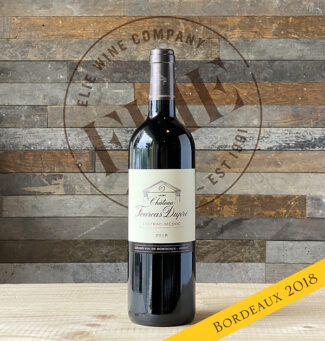
Château Fourcas Dupré Listrac-Médoc ($22)
Nearly equal parts Cabernet Sauvignon and Merlot. Ripe currants and blackberry appear in the perfumed aromatics, leading to the ‘sous bois’ (forest floor) character that is typical of the appellation with clove and pepper lingering amid the grainy tannins.
Château de Villegeorge
When ‘Cru Bourgeois’ level was created in 1932, Villegeorge was awarded Exceptional Growth status, one of only six wineries to receive the honor. A scant thirty acres in size, the vineyard blocks of Château de Villegeorge lie within commune of Avensan and has been certified sustainable by Terra Vitis since 2003. Currently owned by dynamic enologist Marie-Laure Lurton, the estate is said to only now be approaching its full potential, with consistent wines that offer richness as well as a stylish structure and concentration.

Château de Villegeorge Haut-Médoc ($22)
A welcoming wine with a whiff of anise in the top notes and a flood of black fruits, black currant, blackberry, black cherry to loft the palate through silky tannins and a persistent finish. Three quarters Cabernet Sauvignon with Merlot in the balance.
Château Sénéjac
For an estate that has had an impact in Haut-Médoc for more than five hundred years, there have been relatively few families at the helm. The original owners held on to the property for two centuries, following which, the de Guignes owned Sénéjac from 1860 until 1999 when they sold to Lorraine Cordier, the owner of Chateau Talbot in Saint-Julien, Following Lorraine’s death in 2011, the estate was taken over by her sister, Nancy Bignon Cordier. Originally, Sénéjac was known for producing white Bordeaux, although currently, production is exclusively red.

Château Sénéjac Haut-Médoc ($22)
The is 59% Cabernet Sauvignon, 29% Merlot, 7% Cabernet Franc and 5% Petit Verdot. A nose of a nose of warm berries, damp earth, perfumed dried flowers and fresh tobacco with some green pepper notes and a distinct, dusty garrigue underneath and nice chewy tannins on the finish.
- - -
Posted on 2021.10.06 in France, Bordeaux, Wine-Aid Packages | Read more...
Featured Wines
- Notebook: A’Boudt Town
- Saturday Sips Wines
- Saturday Sips Review Club
- The Champagne Society
- Wine-Aid Packages
Wine Regions
Grape Varieties
Aglianico, Albarino, Albarín Tinto, Alicante Bouschet, Aligote, Altesse, Arbanne, Arcos, Auxerrois, Barbarossa, Beaune, Biancu Gentile, Bonarda, bourboulenc, Cabernet Sauvignon, Calvi, Carcajolu-Neru, Chenin Blanc, Cinsault, Clairette, Cortese, Corvinone, Cot, Counoise, Dolcetto, Erbamat, Fiano, folle Blanche, Fumin, Gamay, Garganega, Garnacha Tintorera, Godello, Graciano, Grenache, Grenache Blanc, Grolleau, Groppello, Jacquère, Juan Garcia, Lladoner Pelut, Macabeo, Maconnais, Malbec, Malvasia, manseng, Marcelan, Marsanne, Marselan, Marzemino, Melon de Bourgogne, Mencía, Merlot, Montepulciano, Montònega, Moscatell, Mourv, Mourvèdre, Muscadelle, Muscat, Natural, Nebbiolo, Nero d'Avola, Niellucciu, Palomino, Parellada, Patrimonio, Pecorino, Pedro Ximénez, Persan, Petit Meslier, Pineau d'Aunis, Pinot Auxerrois, Pinot Blanc, Pinot Gris, Pinot Meunier, Pinot Noir, Pouilly Fuisse, Pouilly Loche, Riesling, Rousanne, Sagrantino, Sangiovese, Sauvignon, Sciacarellu, Semillon, Serine, Sumoll, Tempranillo, Teroldego, Timorasso, Trebbiano Valtenesi, Treixadura, trepat, Trousseau, Ugni Blanc, Vermentino, Viognier, Viura, Xarel-loWines & Events by Date
- September 2025
- August 2025
- July 2025
- June 2025
- May 2025
- April 2025
- March 2025
- February 2025
- January 2025
- December 2024
- November 2024
- October 2024
- September 2024
- August 2024
- July 2024
- June 2024
- May 2024
- April 2024
- March 2024
- February 2024
- January 2024
- December 2023
- November 2023
- October 2023
- September 2023
- August 2023
- July 2023
- June 2023
- May 2023
- April 2023
- March 2023
- February 2023
- January 2023
- December 2022
- November 2022
- October 2022
- September 2022
- August 2022
- July 2022
- June 2022
- May 2022
- April 2022
- March 2022
- February 2022
- January 2022
- December 2021
- November 2021
- October 2021
- September 2021
- August 2021
- July 2021
- June 2021
- May 2021
- April 2021
- March 2021
- February 2021
- January 2021
- December 2020
- November 2020
- October 2020
- September 2020
- August 2020
- July 2020
- June 2020
- May 2020
- April 2020
- March 2020
- February 2020
- January 2020
- December 2019
- November 2019
- October 2019
- September 2019
- August 2019
- July 2019
- June 2019
- May 2019
- April 2019
- March 2019
- February 2019
- January 2019
- December 2018
- November 2018
- October 2018
- September 2018
- August 2018
- July 2018
- June 2018
- May 2018
- April 2018
- March 2018
- February 2018
- January 2018
- December 2017
- November 2017
- October 2017
- September 2017
- August 2017
- July 2017
- June 2017
- May 2017
- April 2017
- March 2017
- February 2017
- January 2017
- December 2016
- November 2016
- October 2016
- September 2016
- August 2016
- July 2016
- June 2016
- May 2016
- April 2016
- March 2016
- February 2016
- January 2016
- December 2015
- November 2015
- October 2015
- September 2015
- August 2015
- July 2015
- June 2015
- May 2015
- April 2015
- March 2015
- February 2015
- January 2015
- December 2014
- November 2014
- October 2014
- September 2014
- August 2014
- July 2014
- June 2014
- April 2014
- March 2014
- February 2014
- January 2014
- December 2013
- November 2013
- October 2013
- September 2013
- August 2013
- July 2013
- June 2013
- May 2013
- April 2013
- March 2013
- February 2013
- January 2013
- December 2012
- November 2012
- October 2012

